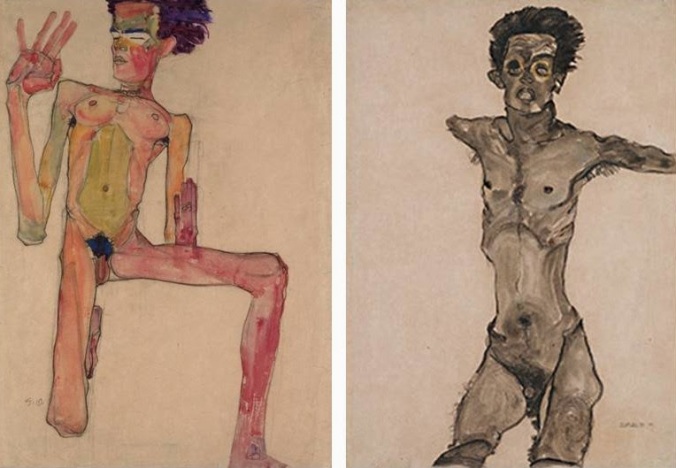 Schiele, Self-Portrait with Chinese Lantern Plant, 1912
Schiele, Self-Portrait with Chinese Lantern Plant, 1912
Although the life of Egon Schiele was short lived, the number of works he created was quite prolific. Born in 1890 Austria, Schiele and his two sisters were raised by his father. His sister, Gertie, often modeled in the artist’s works. In school, Egon was encouraged to pursue formal training in the arts. After the death of his father in 1906, Schiele enrolled in the Akademie der bildenden Kunste, Vienna’s Academy of Fine Arts, where Schiele’s future mentor, Gustav Klimt, also studied.
A year after enrolling in the school, Egon sought out Klimt as a confidant who in turn introduced Klimt to patrons as well as the work of other artists. Klimt also introduced Schiele to the Wierner Werkstätte, a division of the Vienna Secession that focused on unifying the arts and crafts. Two years later, Schiele was one of many students to leave the Academy. After leaving, Schiele explored new methods of painting and began to veer from his mentor’s artistic influence.
Egon, along with the rest of the artists that chose to leave the academy, began frequently exhibiting their works. As these exhibitions progressed, Schiele’s work began to mature. Subjects that he often explored were sexuality and self-portraits. Many critics considered the young artist’s work to be crude and vulgar. During this time, Schiele often used nude adolescents as models. This practice eventually led to his 24-day imprisonment in 1912 after being accused of raping an underage girl, his girlfriend at the time. Schiele ceased to using children as models but this did not put a damper on his sexually explicit artwork.

Egon Schiele – Kneeling Nude with Raised Hands, 1910/ Nude Self-Portrait in Grey with Open Mouth, 1910
In addition to its graphic nature, Schiele’s work often portrayed distorted contours and angular human figures. His self-portraits, which inwardly explored the artist’s own turmoil, were no exception. Egon is nude in many of his self-portraits and he poses himself in vulnerable positions. The self-reflective aspect of Schiele’s portraits is considered to be a precursor to Expressionism, a movement that explores emotional experiences rather than an external environment. Schiele’s work garnered more attention when he was invited to participate in the Vienna Secession’s Forty-Ninth Annual Exhibit in March of 1918. Unfortunately, his career ended abruptly in October of that year, when he died due to the Spanish Influenza. Schiele was only 28 at the time of his passing yet the art he created throughout his career proved him to be one of the most productive and innovative artists of his time.
Sources:
- http://www.theartstory.org/artist-schiele-egon.htm
- https://commons.wikimedia.org/wiki/File:Egon_Schiele_-_Self-Portrait_with_Physalis_-_Google_Art_Project.jpg
- http://www.widewalls.ch/artist/egon-schiele/